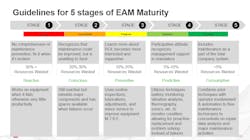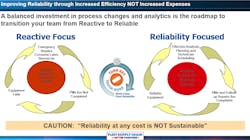When it comes to maintenance methodology, there are two different approaches: the reactive approach and prescriptive action. The difference in attitudes can be the difference between a sustainable and unsustainable fleet business model.
“Reactive is you fix it when it breaks,” Kevin Price, the technical product evangelist and strategist for Infor, said during a FleetOwner webinar on transitioning fleets from reactive to predictive maintenance. “On the entire opposite side of the spectrum, you’ll find prescriptive action. Prescriptive action is where you want to be for those assets that are high risk to you.”
The reactive approach to maintenance creates obstacles for fleets, Price said. There is no roadmap or fully defined strategy, it usually lacks an executive buy-in, and leads to ever-changing expectations of customers and shareholders.
The prescriptive action, on the other end, is driven by improved efficiency, waste reduction, safety, reliability and asset performance. This maintenance approach also puts pressure on fleets to make digital transformations and helps them protect aging equipment while looking toward smart investments on modern equipment.
You not only need data to make better predictive maintenance decisions — but you need to know what to do with that data. “A lot of folks have access to this data and they know it’s there,” Price said. “But how do I use it? When do I use it? Why should I use it? These questions are common.”
Price showed off guidelines for five stages of enterprise asset maintenance (EAM) maturity, which can help executives determine which assets need upgrades immediately and which can wait. The stages move from reactive to consumptive and, as Price noted, with each step, fewer resources are wasted by companies:
- Reactive: Works on equipment when it fails; otherwise little productivity (more than 30% of resources wasted).
- Conscious: Still reactive but rebuilds significant components and has spare parts available when failures occur (20% to 30% resources wasted).
- Preventive: Uses routine inspections, lubrication, adjustments, and minor service to improve the mean time between failure (MTBF) of equipment. (10% to 20% resources wasted.)
- Predictive: Uses techniques including battery monitoring, vibration analysis, thermography, etc., to monitor conditions, allowing for proactive replacement and problem solving instead of failures (5% to 10% resources wasted).
- Consumptive: Combines previous techniques with operator involvement and automation to free maintenance technicians to concentrate on repair data analysis and major maintenance activities (Less than 5% resources waste).
While the resources wasted reduce as a fleet moves to each step, the impact on a company gets larger, Price said. “The dollar amount, the uptime availability, the accountability of forecasting resources and materials and tools and contractors, it starts to become more and more and more reliable because you're building that into your framework. You're building that into the mindset. You're building that into where you want to be.”
PepsiCo (which includes Frito-Lay and other top global brands) operates about 70,000 assets in North America — including more than 11,000 tractors, 14,000 vans, 3,500 trucks, and 17,500 trailers — making it the second-largest private fleet on the continent, according to the FleetOwner 500.
Bob Zimmer, supply chain fleet technology senior manager at PepsiCo, has nearly 35 years of fleet experience. He co-designed and deployed the company’s global telematics strategy, which included creating PepsiCo’s sustainable automated reporting and technician diagnostic tool strategy. If you are only waiting until assets break before you fix them, it creates a “never-ending circle,” Zimmer said. “We want to focus on being reliable versus reactive.”
With a reactive focus, emergency repairs consume a fleet’s labor resources, he noted, which can lead to preventive maintenance (PM) not being completed, which then makes the equipment more susceptible to failure. This circle leads to negative impacts on your business, Zimmer said.
The opposite is a reliability-focused approach to maintenance. With effective analysis, planning and smart technician scheduling, it leads to completed PMs and follow-up repairs completed on time. That all adds up to reliable equipment.
PepsiCo uses telematics to know its assets are in the yard, returning to the yard or leaving the yard. “Those are the three key times in which technicians should be on-site to help our drivers with any questions or immediate concerns,” Zimmer explained. “That gets PMs completed and repairs completed.”
He added that by relying on telematics to know when a majority of assets are on the lot, helps the company effectively plan its technicians’ time and staffing. “In terms of the PM and follow-up repairs, if we can now attach (the telematics to) where the vehicle is. What's the use case? What’s the use cycle for that vehicle? When's it available? When's it need to be on the road? We can then schedule our PM accordingly, as well as do a quick snapshot of our telematics software and give that to a technician.”
This workflow, Zimmer said, provides PepsiCo with the confidence of “highly reliable equipment and reliability drive productivity significantly. You can imagine the cost to send out a tow truck, hook up a trailer, offload that trailer to another trailer you had to bring out there. Tow that trailer back to the shop, which may or may not eat your shop because where that trailer broke down might be way far away from where your shop is. So now you've got to go to an outside vendor for a repair that could have been picked up at PM time — or should have been picked up at the PM time. And had it been picked up at PM time, none of those costs would have been incurred.”
Thes types of costs, Zimmer points out, are unstainable for a business. And with a proper proactive approach to maintenance, he said a fleet can prevent 98% of emergency repairs.
The July 29 FleetOwner webinar, “Transition from reactive to predictive maintenance,” is available to watch on-demand for free. A schedule of upcoming more free webinars geared toward fleet executives and managers is also available.
About the Author
Josh Fisher
Editor-in-Chief
Editor-in-Chief Josh Fisher has been with FleetOwner since 2017. He covers everything from modern fleet management to operational efficiency, artificial intelligence, autonomous trucking, alternative fuels and powertrains, regulations, and emerging transportation technology. Based in Maryland, he writes the Lane Shift Ahead column about the changing North American transportation landscape.



